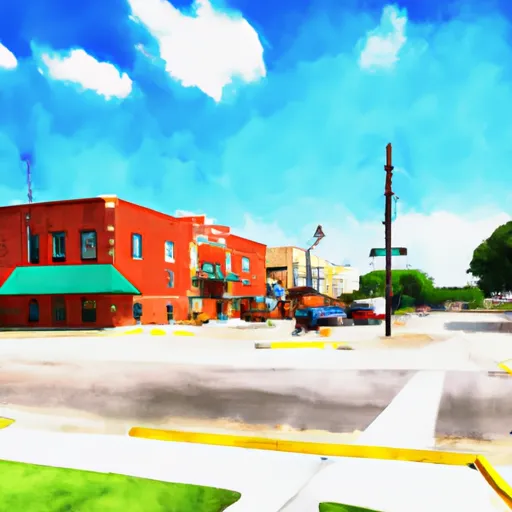-
 Snoflo Premium
Snoflo Premium
Get unlimited access to all our content
With no Ad interruptions! - Start Your Free Trial Login with existing account
Marlin
Eden Index
Climate
8.3
•
Recreation
1.4
•
Community
1.4
•
Safeguard
4.1/10

Marlin, Texas is a small city located in Falls County, Central Texas. Situated in the southern part of the United States, Marlin experiences a humid subtropical climate characterized by hot, humid summers and mild winters. Summer temperatures can reach up to the mid-90s Fahrenheit (mid-30s Celsius), while winter temperatures range from the mid-40s to mid-60s Fahrenheit (5-15 degrees Celsius). Rainfall is spread throughout the year, with the wettest months being May and October.
Hydrologically, Marlin is located close to the Brazos River, which provides a significant water source for the region. Additionally, several creeks and streams flow through the area, contributing to the hydrological makeup of Marlin.
For outdoor enthusiasts, Marlin offers various recreational opportunities. The city is located near Lake Limestone, a popular destination for boating, fishing, and camping. The lake is known for its diverse fish population, including bass, catfish, crappie, and sunfish. Nearby parks and wildlife management areas provide opportunities for hiking, birdwatching, and hunting. Overall, Marlin offers a pleasant climate, abundant water resources, and a range of outdoor activities for residents and visitors to enjoy.
What is the Eden Index?
The Snoflo Eden Index serves as a comprehensive rating system for regions, evaluating their desirability through a holistic assessment of climate health, outdoor recreation opportunities, and natural disaster risk, acknowledging the profound impact of these factors on livability and well-being.
Climate Health Indicator (CHI): 8.3
Marlin receives approximately
949mm of rain per year,
with humidity levels near 84%
and air temperatures averaging around
20°C.
Marlin has a plant hardyness factor of
8, meaning
plants and agriculture in this region tend to thrive here all year round.
By considering the ideal temperature range, reliable water supplies, clean air, and stable seasonal rain or snowpacks, the Climate Health Indicator (CHI) underscores the significance of a healthy climate as the foundation for quality living.
A healthy climate is paramount for ensuring a high quality of life and livability in a region, fostering both physical well-being and environmental harmony. This can be characterized by ideal temperatures, reliable access to water supplies, clean air, and consistent seasonal rain or snowpacks.
Weather Forecast
Streamflow Conditions
Lower Brazos
Area Rivers
Lower Brazos
Snowpack Depths
Lower Brazos
Reservoir Storage Capacity
Lower Brazos
Groundwater Levels
Recreational Opportunity Index (ROI): 1.4
The Recreational Opportunity Index (ROI) recognizes the value of outdoor recreational options, such as parks, hiking trails, camping sites, and fishing spots, while acknowledging that climate plays a pivotal role in ensuring the comfort and consistency of these experiences.
Access to outdoor recreational opportunities, encompassing activities such as parks, hiking, camping, and fishing, is crucial for overall well-being, and the climate plays a pivotal role in enabling and enhancing these experiences, ensuring that individuals can engage in nature-based activities comfortably and consistently.
Camping Areas
| Campground | Campsites | Reservations | Toilets | Showers | Elevation |
|---|---|---|---|---|---|
| Oak Thicket Park - Fayette Lake | 20 | 405 ft | |||
| Liberty Hill - Navarro Mills Reservoir | 110 | 467 ft | |||
| Town Square - Fayetteville | None | 409 ft | |||
| Pecan Point - Navarro Mills Reservoir | 35 | 462 ft | |||
| Park Prarie - Lake Fayette | 12 | 406 ft | |||
| Wolf Creek - Navarro Mills Reservoir | 70 | 464 ft | |||
| Highview - Bardwell Lake | 40 | 432 ft | |||
| Nails Creek - Lake Somerville State Park | 60 | 276 ft | |||
| Falls on the Brazos Park | 15 | 335 ft | |||
| Oak Park - Navarro Mills Reservoir | 50 | 465 ft |
Nearby Ski Areas
Catastrophe Safeguard Index (CSI):
The Catastrophe Safeguard Index (CSI) recognizes that natural disaster risk, encompassing floods, fires, hurricanes, and tornadoes, can drastically affect safety and the overall appeal of an area.
The level of natural disaster risk in a region significantly affects safety and the overall livability, with climate change amplifying these risks by potentially increasing the frequency and intensity of events like floods, fires, hurricanes, and tornadoes, thereby posing substantial challenges to community resilience and well-being.
Community Resilience Indicator (CRI): 1.4
The Community Resilience Indicator (CRI) recognizes that education, healthcare, and socioeconomics are crucial to the well-being of a region. The CRI acknowledges the profound impact of these elements on residents' overall quality of life. By evaluating educational resources, healthcare accessibility, and economic inclusivity, the index captures the essential aspects that contribute to a thriving community, fostering resident satisfaction, equity, and social cohesion.

